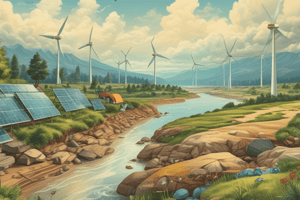Podcast
Questions and Answers
What are some examples of renewable energy sources mentioned in the text?
What are some examples of renewable energy sources mentioned in the text?
solar photovoltaic systems, wind turbines, hydroelectric power plants, geothermal facilities, biomass heating and electricity generation, biofuels for transportation
What environmental conservation strategy aims to restore native plant communities and increase biodiversity?
What environmental conservation strategy aims to restore native plant communities and increase biodiversity?
Rewilding efforts
How does sustainable agriculture help combat climate change?
How does sustainable agriculture help combat climate change?
Sustainable agriculture boosts food security and resiliency while reducing greenhouse gas emissions.
What are some examples of eco-friendly agricultural techniques mentioned in the text?
What are some examples of eco-friendly agricultural techniques mentioned in the text?
How do reuse, recycling, and circular economy principles contribute to environmental conservation?
How do reuse, recycling, and circular economy principles contribute to environmental conservation?
What are some effects of climate change on Earth's ecosystem?
What are some effects of climate change on Earth's ecosystem?
How do human activities contribute to climate change?
How do human activities contribute to climate change?
Why is it important to promote renewable energy sources?
Why is it important to promote renewable energy sources?
What is the goal of sustainable agriculture practices in terms of environmental sustainability?
What is the goal of sustainable agriculture practices in terms of environmental sustainability?
How can effective conservation strategies help secure the future of our world?
How can effective conservation strategies help secure the future of our world?
Study Notes
Environmental Sustainability: Understanding Its Components
Environmental sustainability is a crucial concept aimed at ensuring our planet's health by balancing human needs with protecting natural resources. As we delve into its components, let's explore how addressing climate change effects, utilizing renewable energy sources, promoting sustainable agriculture practices, and employing effective conservation strategies can help secure the future of our world.
Climate Change Effects
Climate change has brought about an alarming shift in global temperatures, precipitation patterns, sea levels, and numerous other aspects of Earth’s ecosystem. Human activities such as burning fossil fuels and deforestation have released vast amounts of greenhouse gases like carbon dioxide, methane, and nitrous oxide, trapping heat in the atmosphere. This leads to rising ocean and land surface temperatures, melting glaciers and ice caps, intensified hurricanes and storm surges, more frequent droughts, and increased likelihood of flooding events. All these changes pose serious threats to life, infrastructure, and economies worldwide.
Renewable Energy Sources
To mitigate climate change effects and reduce reliance on limited nonrenewable reserves, governments and society increasingly rely on cleaner, greener alternatives. These include solar photovoltaic systems, wind turbines, hydroelectric power plants, geothermal facilities, biomass heating and electricity generation, and biofuels for transportation. Incorporating renewables helps decrease greenhouse gas emissions while also diversifying energy portfolios and reducing our vulnerability to fluctuations in commodity prices.
Sustainable Agriculture Practices
Agricultural production contributes significantly to global greenhouse gas emissions through livestock waste management, tillage, manure application, crop residue decomposition, and rice cultivation. To address this issue, farmers and policymakers implement various eco-friendly agricultural techniques. Some examples include reduced tillage methods, improved nutrient management, integrated pest management, agroforestry, and precision farming technologies to optimize water, fertilizer, and chemical usage. By doing so, sustainable agriculture boosts food security and resiliency while helping combat climate change.
Environmental Conservation Strategies
The implementation of environmentally friendly practices extends beyond agriculture alone. Countless initiatives aim to conserve species, habitats, and ecosystem services across all sectors encompassed within environmental policy. Among these measures, rewilding efforts restore native plant communities, promote natural landscapes, increase biodiversity, enhance wildlife corridors, and improve overall landscape connectivity. Similarly, habitat banking programs create new habitats where they do not exist, offsetting degradation elsewhere. Notably, reuse, recycling, and circular economy principles drive down resource consumption and waste production.
Global Warming Impacts
As evidenced from the preceding sections, climate change affects nearly every aspect of daily living—threatening public safety, economic stability, and ecological integrity. Mitigation and adaptation strategies must consider these cascading consequences when designing local policies and international agreements. Governments and organizations around the globe work tirelessly to minimize global warming impacts and preserve a healthy, habitable future for generations to come.
In conclusion, environmental sustainability integrates climate change mitigation, incorporating renewable energy sources, implementing sustainable agriculture practices, and conservational strategies, ultimately striving to limit the devastating global warming impacts. Together, humanity must confront today’s pressing challenges head-on, embracing change and innovation, and fostering unity among nations in pursuit of a brighter tomorrow.
Studying That Suits You
Use AI to generate personalized quizzes and flashcards to suit your learning preferences.
Description
Explore the components of environmental sustainability, including climate change effects, renewable energy sources, sustainable agriculture practices, and conservation strategies. Learn how these elements contribute to mitigating global warming impacts and securing a healthier future for our planet.




